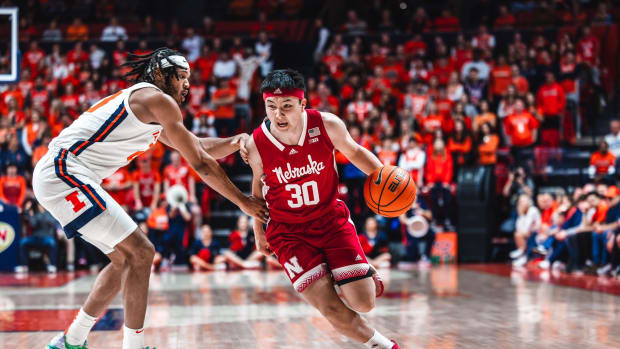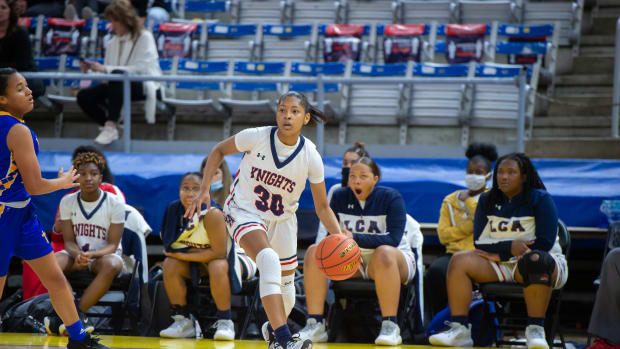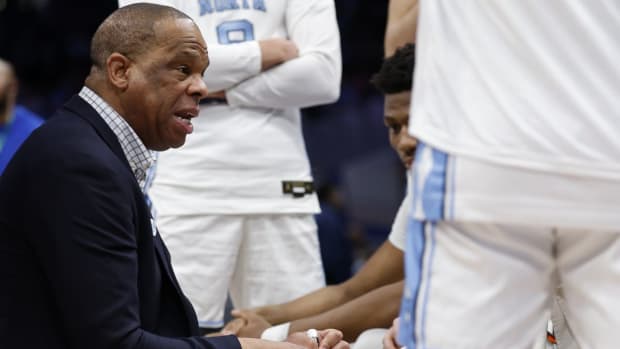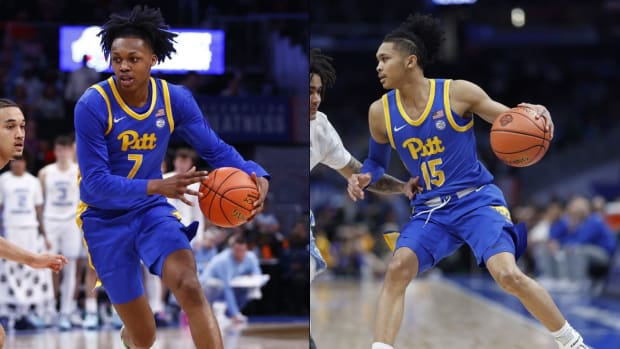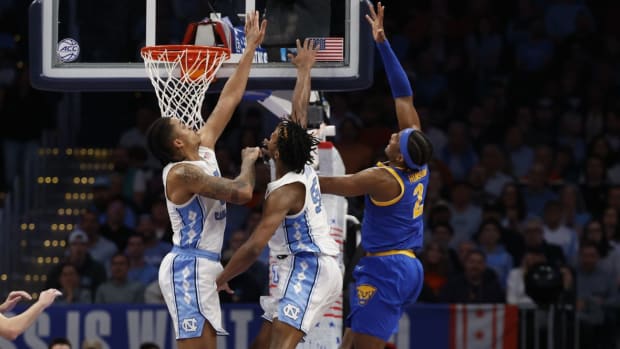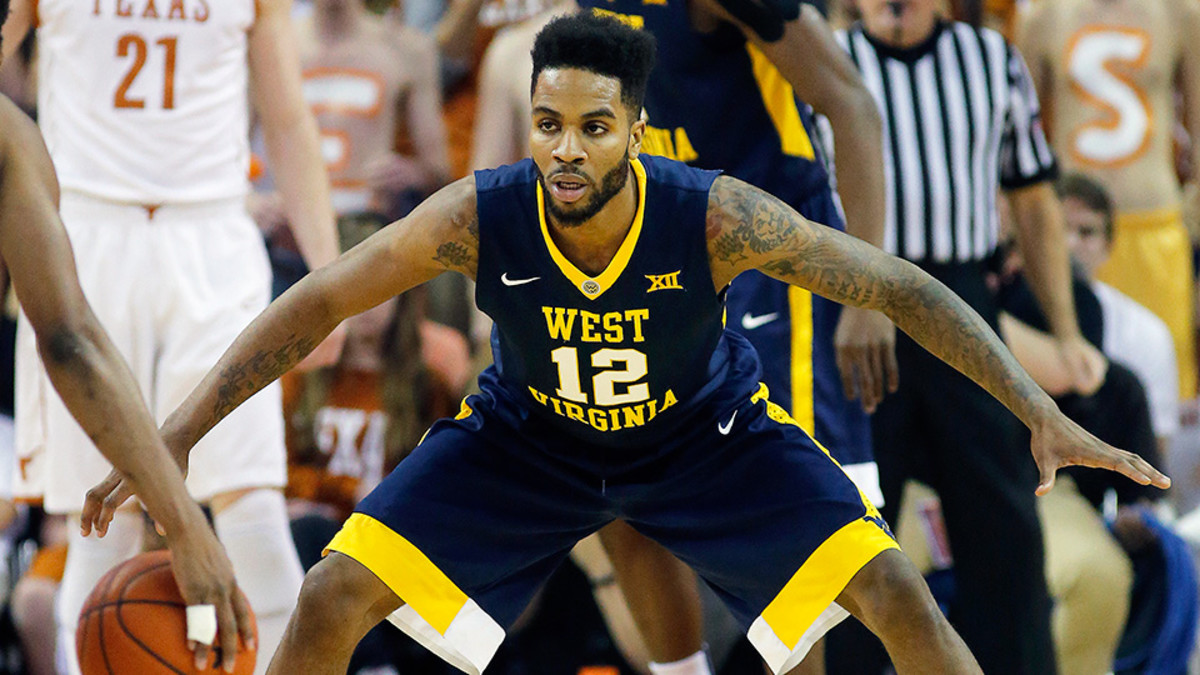
The 2016 Effy Awards: West Virginia, Syracuse win defensive honors
Get all of Luke Winn’s columns as soon as they’re published. Download the new Sports Illustrated app (iOS or Android) and personalize your experience by following your favorite teams and SI writers.
SI presents The Effys: the least ambiguous and least prestigious postseason awards in college basketball. Every award is based on efficiency or other advanced metrics. No voting—just analytics.
Part I of The Effys covered coaching awards. Part II, below, covers defensive awards. Winners were based on a blend of individual and team defensive-analytic data, as individual data rarely tells the entire story of a defender’s impact.
Effy Defensive Team of the Regular Season
West Virginia
The Mountaineers earned this by having the nation’s most suffocating, entertaining and ridiculous defense. Their formula for success was mind-boggling. While full-court pressing constantly, they fouled like mad, giving up the highest ratio of free throw attempts to field goal attempts (.553, which meant their opponents took more than one FTA for every two FGAs). But they created takeaways at a wild rate, too, leading major-conference teams in turnovers-forced percentage (25.0) by a wide margin. The turnovers, combined with solid defensive rebounding, allowed West Virginia to have the stingiest defense in the nation’s toughest conference, allowing 0.981 PPP in Big 12 play. The Mountaineers finished sixth overall in kenpom.com’s adjusted defensive efficiency rankings in the regular season. They also hold claim to the title of having held Oklahoma’s Buddy Hield to his lowest point total as a senior: six, in the Big 12 tournament semifinals.
The SI Extra Newsletter Get the best of Sports Illustrated delivered right to your inbox
Subscribe
Effy Defensive Team of the NCAA Tournament (minimum four games played)
Syracuse
For SI’s study on the most dominant NCAA tourney title runs of the analytics era, I ran competition-adjusted efficiency splits on every team that reached the 2016 Elite Eight. And while the main conclusion was that Villanova had the most dominant title run of the entire era, the data also indicated that Syracuse had 2016’s most impressive defensive NCAA tournament. The Orange’s adjusted defensive efficiency over five games was 0.877 PPP, just beating out ‘Nova’s 0.881. The Final Four game against North Carolina was a flop, but prior to that, the Orange held Dayton and Middle Tennessee to under 0.850 PPP and Gonzaga and Virginia, two of the nation’s better offenses, to under 1.000 PPP.
All-Effy For Interior Defensive Impact: The Elite Eight Power Forwards/Centers
• Vashil Fernandez, 6'10" senior C, Valparaiso: He was the nation’s highest-impact interior defender, and not just because he ranked No. 1 in block percentage, swatting 14.3% of opponents’ two-point attempts. The Crusaders held opponents to just 36.1% shooting on the interior (and 0.86 PPP overall) when Fernandez was on the floor, as opposed to 48.6% (and 0.96 PPP overall) when he was on the bench, according to hooplens.com data. Fernandez also helped Valpo have the nation’s stingiest post defense, allowing just 0.61 PPP, according to Synergy.
• Egidijus Mockevicius, 6'10" senior C, Evansville: The Lithuanian import was nation’s most productive defensive rebounder, grabbing an insane 39.0% of opponents’ misses. He had double-digit defensive boards in 24 of the Aces’ 33 games.
UNC men’s program appears off the hook, but questions linger
• Ismael Sanogo, 6'8" sophomore SF/PF, Seton Hall: He barely played at all as a freshman, but emerged as the Big East’s best hybrid defender as a sophomore, leading the Pirates’ 138-spot rise (to No. 8) in the national defensive efficiency rankings. Sanogo is a long-armed deflection machine who can defend wings and posts.
• Chinanu Onuaku, 6'10" sophomore C, Louisville: Anchored the nation’s most efficient major-conference D, while ranking in the national top 40 in block and defensive-rebound percentage.
• Daniel Ochefu, 6'11" senior C, Villanova: One of just five major-conference big men with better than 20/5/2 in defensive-rebound/block/steal percentage on the season. In the NCAA tournament, the Wildcats’ defense allowed 0.93 PPP when "The Chef" was on the floor, and 1.11 PPP with him on the bench.
• Gary Clark, 6'8" sophomore PF, Cincinnati: As an undersized boards-blocks-steals machine who knows how to stay out of foul trouble, Clark was the star of the nation’s No. 15 defense and one of the most valuable players in the AAC.
• A.J. Hammons, 7-foot senior C, Purdue: He didn’t do anything flashy—he just served as the rim-protecting-and-rebounding anchor of a conservative, one-shot-and-done defense.
• Brice Johnson, 6'10" senior PF, North Carolina: Johnson keyed the Tar Heels’ second-half defensive turnaround, leading the ACC in defensive-board percentage and finishing in the league’s top 10 in block and steal percentage.
All-Effy For Perimeter Defensive Impact: The Elite Eight Guards/Wings
• Alex Caruso, 6'5" senior PG, Texas A&M: The turnover-creating leader of a D that ranked No. 12 in efficiency. Caruso was a strong on-ball defender and one of the best off-ball anticipators I studied on film all season. He had a defensive-back like ability to bait passers into making ill-advised decisions that led to turnovers.
• Jeremy Morgan, 6'5" junior SG/SF, Northern Iowa: He achieved some fame for scoring 36 points and grabbing 12 boards in the Panthers’ epic-collapse game against Texas A&M in the NCAA tourney’s second round, but deserves more recognition for a multi-year run as one of the nation’s best wing defenders. Morgan is a highly active 6'5" guard who can defend three positions and posted impressive steal (3.8%) and block (3.4%) percentages as a junior.
• Malcolm Brogdon, 6'5" senior SG, Virginia: He became the Cavaliers’ soundest defender by his senior season, getting praised by opposing coaches for his mastery of driving and passing angles, as well as his ability to guard four positions. (See Brogdon’s NCAA tournament work against Butler’s Andrew Chrabascz for evidence of his ability to defend power forwards.) Brogdon’s versatile, mostly mistake-free D helped Virginia finish No. 5 in defensive efficiency despite its lack of a rim protector.
Villanova won title, but was Big East the best conference this year?
• Gary Payton II, 6'3" senior PG, Oregon State: Payton’s on-ball D isn’t elite, but his defensive-board percentage (18.2) from the point guard spot is remarkably high—almost the same as the best rebounding point guard I’ve ever seen at the college level: Rajon Rondo, who grabbed 18.5% of d-boards as a sophomore at Kentucky in 2005–06. Payton’s steal percentage (4.2) was also Rondo-like (4.0 in ‘05-06), and those numbers should get the Beavers’ star a look from the NBA.
• Josh Hart, 6'5" sophomore SF, Villanova: The Wildcats were an incredibly sound defensive team from top to bottom, but Hart was the most versatile defender in their starting lineup, capable of guarding the 1-4 positions when they were in their switching man-to-man, and playing anywhere but the middle of their 2-3 zone. Hart was also one of the nation’s best defensive rebounders (grabbing 18.6% of available boards) from the small-forward spot.
• Eric McClellan, 6'4" senior SG, Gonzaga: A college journeyman who began his career at Tulsa, then transferred to Vanderbilt, and finally ended up at Gonzaga, McClellan found his true calling as a senior, serving as the Zags’ perimeter stopper and occasional leading scorer. His defensive impact was most evident later in the season, too: During their three-game NCAA tournament run, the Zags’ D allowed 0.79 PPP while McClellan was on the floor and 1.09 PPP when he was on the bench.
• Tyler Ulis, 5'9" soph. PG, Kentucky: He had to become a more conservative defender as a sophomore than he was as a freshman, when he could extend pressure with reckless abandon because he had Karl-Anthony Towns and Willie Cauley-Stein as rim-protecting backup. But Ulis remained an on-ball pest, and was a big reason why Kentucky had the SEC’s No. 2 defense despite lacking an interior stopper.
• Fred VanVleet, 6-foot senior PG, Wichita State: The Shockers ranked No. 1 in defensive efficiency and No. 5 in turnovers-forced percentage—and VanVleet was their leader in steal percentage at 3.7. What he lacks in length he makes up for with boxer-like, lightning-quick hands, and Wichita’s D struggled when he was off the floor. On the season, it allowed 0.83 PPP with VanVleet in the lineup and 0.96 PPP when he was sitting, according to hooplens.com.


